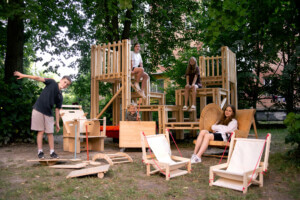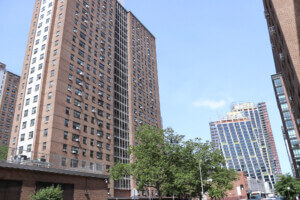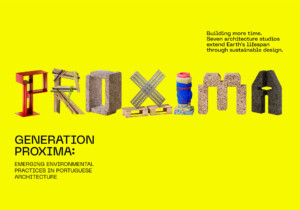A new exhibition helps a New York-based firm explore indoor and outdoor applications of a new building material.
Cosentino is celebrating Architecture Month with Surface Innovation, a multi-media exhibition at the Center for Architecture in New York that presents innovative applications of its new Dekton material. A combination of raw, inorganic materials found in glass, porcelain, and natural quartz, the new indoor/outdoor surfacing material is made with particle sintering technology (PST) that recreates the natural process of stone formation. The company invited six local architecture firms to design unique projects featuring the material, including SOFTlab, a design/build firm known for its mix of research, craft, and technology in large-scale installations and building projects.
For SOFTlab, working with a product that could be used for both interiors and exterior applications was an opportunity to reconcile the growing inverse relationship between the skin and volume of large buildings. “We came up with the idea of building something a little more dense than a single story or residentially scaled building, where Dekton may be used,” said Michael Svivos, founder and director of SOFTlab. “We went to a larger scale building, that blurs the inside and outside.”
- Fabricator SOFTlab
- Designers SOFTlab
- Location New York
- Date of Completion October 2013
- Material paper, adhesive
- Process Maya, Rhino, Grasshopper, laser cutting
Starting with the idea of a vertical atrium, which often includes biophilic elements like water features and indoor gardens, the SOFTlab design team envisioned an ATRIUn, a uniquely shaped building feature that uses the durability of Dekton’s stone-like properties to bring the outdoors in. ATRIUn is sponge shaped, and breaches the structure’s exterior at various points. “It forms an interior plaza in a building, not as something that’s flat, but spans the height, width, and depth of the building,” Szivos said.
The form was generated in Maya. After inserting the apertures along the quadrilinear volume, the physics simulation plug-in generated the smooth, sinuous surface across various levels. For its larger projects, Szivos says the firm typically solves engineering challenges with Arup through an advanced finite software analysis software program. Those optimized, large designs are then sent to Tietz-Baccon, their long-time local fabricator. However for smaller projects where SOFTlab fabricates its own models and project components, the physics tool provides a close approximation of Arup’s services.
To generate a model of ATRIUn’s design for the exhibition, the designers translated the Maya drawing into Rhino with Grasshopper to feed to their in-house laser cutter. Since the design was modeled in paper, four sided shapes were fabricated. If the design was realized in Dekton, triangular shapes would be necessary to achieve the complex curvature of the ATRIUn skin. The set volume was 24 by 24 by 36 inches, scalable for a building between 10 and 12 stories.
ATRIUn and Surface Innovation is on view at the Center for Architecture in New York through October 31.










